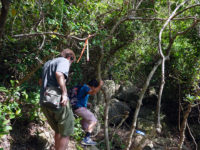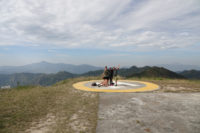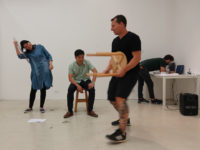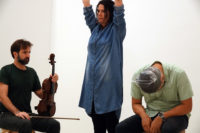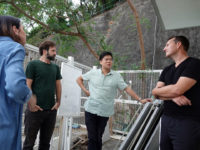For the third and last phase of this year’s programme, individual portraits of the current groups are published in order to give a glimpse into the day-to-day collaborations, convey the intensity of the work process and sketch the interplay between the individual and the collective. Today we present a day in the work of Diego Kohn (composition/performance), Leonard Kai Fung So (fine arts/theory), Marco Spitzbarth (fine arts/digital art) and Ingjerd Ytterdal Holten (fine arts/painting) the result of which will be presented in the final group exhibition 说了/ 没说 : SPOKEN / UNSPOKEN on the 24th November 2018.
- Kohn and So following the ribbons.
- On the peak.
- Rehearsal.
- Training improvisation.
- Reflection.
The foursome started off its collaboration with an unusually long and daring day hike up to Suicide Cliff that—as all of them affirmed later on—was a rocksolid base for their further group work. Since this physically and psychologically demanding take-off, they’ve developed on the work realised by three of them during the Shanghai phase. Mass Prey had dealt with the dominant, even spiritual role that mass consumerism has come to play in today’s society. For the running phase, the group—that went from trio to quartet having won over the experienced Diego Kohn—still focuses on the loop system of mass consumption and production yet aims to place particular emphasis on the lives, lots and neglected rights of Chinese factory workers under the working title Traces from Shanghai. After already having invested some time into exploring and practicing the possibilities of a group performance and just about ten days before the final exhibition, the four individualists convene to discuss their further steps. We meet for lunch in the neighbourhood of Baptist University’s Kai Tak Campus.
To kick off today’s session the group discusses the previous day’s rehearsal. Kohn initiates the brainstorm by questioning whether their effort to improvise made them loose unity. He stresses the necessity of building up mutual trust, familiarity and confidence if the group wants to go deeper into improvising while at the same time maintaining a sense of consistency. By way of being professionally rooted in musical improvisation, Kohn is able to share insights from his discipline while trying to adjust to a setting where his collaborators stem from different artistic backgrounds. The group extensively treats the question how improvisation could be trained in order to allow for both freedom and rhythm. Furthermore, how to combine chaos and control, absurdity and narrative, rule and anarchy?—The black tea in front of me hasn’t even cooled to drinking temperature and these four have already gone straight into the big questions.
While witty So is also fairly familiar with improvisation (and a fairly fearless performer), Ytterdal Holten and Spitzbarth—coming from painting and digital art, respectively—boldly venture into the new artistic terrain, gaining more and more curiosity as well as consciousness for their own performative potential. Another principal concern of the group during this first episode of the work day is how to strengthen the performance they have hitherto developed by creating more interaction and alertness for each other on stage. It is the equally sensitive and articulate Ytterdal Holten who goes on to address the question of how to individualise their roles and attach a character to each without overwriting them. She pleads for the integration of anything that might support the work’s concept but also for doing so in an explorative way by trial and error. In general, “exploration” seems to be one of the key strategies of the group (maybe since they have crawled up that mountain and found ways where there were none?) and probably their pragmatism and fleet-footed progress is due to this very willingness to go ahead and test ideas before they are talked to pieces.
Another issue that propels their lively debates on this Wednesday is how to pay tribute to everyone’s discipline without giving up on the minimalism that their work has so far exuded. In the face of four different artistic biographies, how do you avoid an overload of media and elements? A related issue that preoccupies them is whether to broaden or to deepen the current piece. While Spitzbarth, notorious for his enthusiasm and big-picture thinking, suggests to expand the performance to different sites on the campus’ premises, detail conscious and discerning Kohn prefers to refine the piece’s existing elements in order to attach aesthetic meaning and depth to what is already there. And while Ytterdal Holten proposes to frame the improvisation for more clarity and unity, So suggests to let the absurdity depicted escalate even further. Luckily, the group’s communication is of frank sincerity and none of its members seem to shy away from discord—both of which turn out to be crucial characteristics for gaining common ground.
As the day proceeds, the group is challenged to defend and reflect its current ideas in a mentoring session and later on, after they considered the feedback received, the four of them roll up their sleeves to get straight down into further rehearsing. What’s most striking about this crew of four very contrasting characters is the high level of focus and energy that they bring into their collaboration. They all are fully present, invested and determined to give everything to the project whilst instantly showing a lot of care and listening skills whenever one of them seems hesitant or irritated. Moreover, they somehow manage to preserve a cheerful spirit (however dark-humoured) even during the most heated debates. To an outside observer this is quite remarkable given that, at first glance, they appear to be four rather hard-boiled individualists with strong artistic visions. But maybe it’s not least due to this individualism or, one might say, a certain clarity in their personal artistic expression, that Kohn, So, Spitzbarth and Ytterdal Holten make for a vigorous and resilient team.
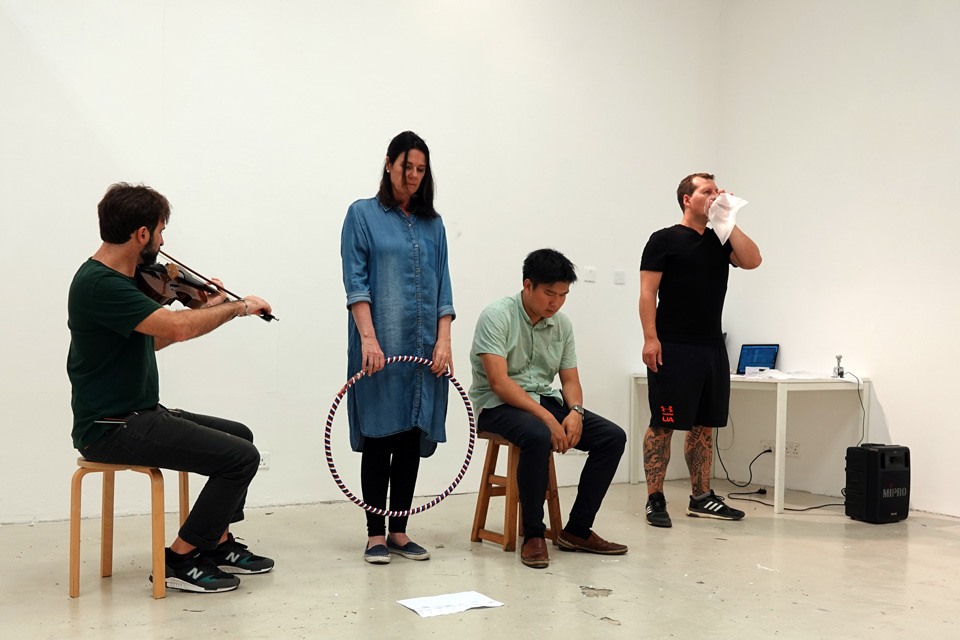
“We are not afraid of the white canvas.” – “…but we tend to put on too much colour.” Ytterdal Holten and Spitzbarth about their group.
Photos by Marco Spitzbarth and Franziska Meierhofer

